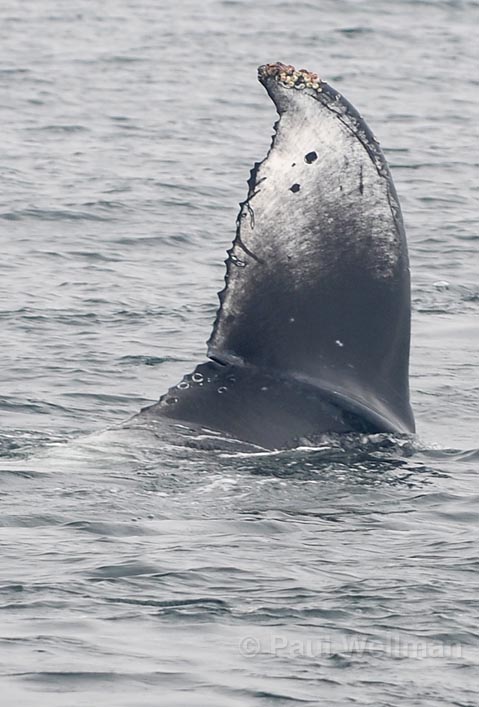A Three Hour Tour:
Humpbacks, Gray Whales Draw Crowds to the Channel

Whale-watchers have reported lots of activity off the coast of Santa Barbara in recent weeks. Groups of Humpbacks have come into the channel to feed and Gray Whales are making their seasonal voyage past the islands as they head north to their own feeding grounds. The Independent was invited aboard The Speed Twin, operated by Capt. Don’s Cruises, to observe these gigantic visitors up close.
While the thought of whale-watching may bring memories of nausea or Dramamine-induced drowsiness, the truth is that – contrary to popular belief – not all Santa Barbara residents own a yacht. Tours like Capt. Don’s and the many other whale-watching companies operating in the channel may be the only opportunity for SB residents to explore and enjoy the vast richness of natural life in the waters that they might otherwise take for granted. Seeing marine wildlife up close is impressive and inspires a powerful appreciation for nature. It also educates viewers about the importance of conservation efforts, both in the Santa Barbara Channel and around the globe.
Of course whale watching is not just for locals. Like most activities in Santa Barbara, the whales draw a huge number of tourists out into our waters. On board the The Speed Twin, captained by Steve Earwood, the gray skies made it hard to spot flukes and other signs of whales on the horizon, but Earwood called sightings out from the pilothouse of the boat. There were passengers from as far away as Germany and Holland whose friends had recommended they spend the afternoon searching the waters for signs of whale life. Although crowded against the railing and tossed by the sea, they were genuinely pleased with their experience, but one woman commented that next time she would bring a better camera. The Jay family from Boston, MA had seen a sign for the tour while strolling along the pier, deciding then to spend the afternoon hunting for humpbacks. As a result, they were unprepared for the chilly climes. Not even their New England blood could compensate for the shorts they were sporting and the windbreakers they’d forgotten. Regardless, the family was enthusiastic about the many whale sightings they witnessed that afternoon.
According to Capt. Don, it is unusual to see Humpback Whales in the channel this early in the year. And it was certainly a rare treat to see so many of them sharing the waters with the migrating Grey Whales, who had swum up from the protected lagoons of Baja California with a bevy of newborn calves. Having so many whales in the channel creates worries of other tragic collisions between whales and large ships; like g>the Blue Whale corpses that washed up on Ventura and Santa Barbara beaches in late 2007 and early 2008.
Although we did not have Capt. Don himself on hand, we did have the vast knowledge of Carole Rosales of Camarillo, who pointed out various aquatic mammals and sea birds to the passengers huddled on the bow of the boat. Rosales is one of the 100-plus members of the Channel Islands Naturalist Corps, a volunteer group dedicated to educating visitors to the Channel Islands and its surrounding waters about the abundance of natural beauty in the area. The group volunteers at various locations, such as Channel Islands National Park, but they have also struck a deal with the captains of the various whale-watching excursions to have one to two volunteers on hand during every tour to answer any questions passengers may have. Rosales and her companions volunteer a minimum of eight hours a month and have undergone a five-week-long course on all topics related to the ecology and preservation of the Santa Barbara Channel, making them a crucial – and helpful – addition to any whale-watching trip.
Out past the oil rigs that dotted our horizon, in an area where the channel waters are up to 500 feet deep, we found a few different groups of Humpbacks feeding on plentiful amounts of krill. The boat idled in the calm waters of the channel as we waited several minutes between glimpses of the ocean leviathans that were diving deep to reach their lunch. Shouts from one side of the boat would send the whole crowd shifting, while another whale would surface at the exact spot the bunch had vacated. At one point it seemed we were surrounded by a dozen different whales, but at other times there were long stretches without even so much as a spout on the horizon. Depending on whom you asked, the day rated from amazingly successful to slightly disappointing.
While the young children who had not yet regurgitated their snacks marveled at the lumbering Humpbacks, rookie deckhand Scott Earwood told stories of a Humpback that only a few days prior had fully breached four times in succession at a spot much closer to the harbor than where we were. While we were not lucky enough to see such a dazzling aerobatic display, we saw plenty of whales and other sea life. Anyone who has been whale watching will tell you that it can be a hit-or-miss affair, but with these giant sojourners currently traveling so close to home – and their environment in an ever-deteriorating and inhospitable state – the odds are certainly not getting any better for people interested in an awe-inspiring close encounter with this truly noble and endangered species.



